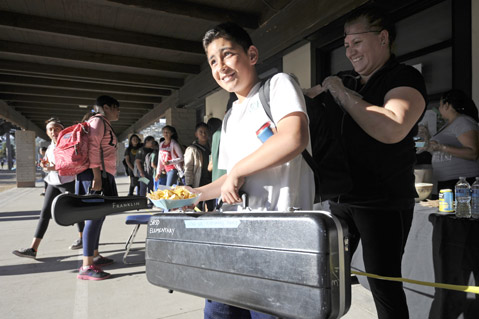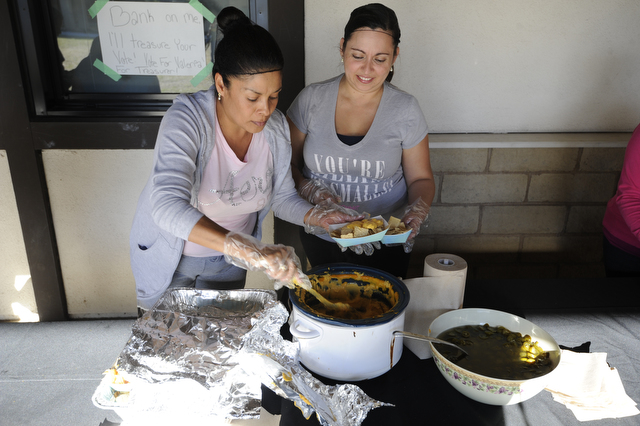Parent Funding at Public Schools a Must
But Does the New Model Give Some Campuses an Unfair Advantage

One recent Thursday, several 6th grade parents at Franklin Elementary School poured nacho cheese over corn chips as kids wearing backpacks formed a long line.
Half a dozen or so parents spend many hours every week prepping for these sales, which are just one of the Eastside school’s creative and decidedly labor-intensive efforts to raise money. “It’s a lot,” Parent Teacher Association (PTA) president Maria Perez said in Spanish. The weekly sales supplement the school’s bigger fundraisers, such as the spring rodeo, move-athon, and pozole night.
Franklin exemplifies a trend in California public schools where voluntary contributions are becoming more essential — increasingly they are line items in the budget rather than icing on the cake. Franklin’s PTA, which determines how to spend the raised money, funds a field trip or gives teachers cash for classroom supplies.

At Franklin — a Title I school that receives extra government money based on its disadvantaged student population — the donation account has grown in the past five years from less than $7,000 annually to about $40,000. Seven years ago, when Principal Casie Killgore came on, the PTA was made up of teachers and a few parents. Now, the PTA has 45 members. “Wow, has it changed,” Killgore said. Last Thursday, the entire 4th grade class — 97 kids — took a boat to Santa Cruz Island for a day. Five parents went, too. “It’s a lot more hands-on,” she said.
But the $300 Franklin parents raise from weekly snack sales is much less than the amount raised by more affluent schools in the district. On the other side of town, Washington Elementary School asks parents for $500 at the start of each year with the caveat that any amount is appreciated. The “annual appeal” brings in more than $150,000, a large portion of their overall $500,000 operational budget.
In some ways, it’s an old story: the well-known tale of the haves and the have-nots. Schools with richer parents raise more money than schools with poorer families. But district officials are not totally clear on the fluidity of private funds flowing through campuses.
Superintendent David Cash said the school district does not have access to, control of, or accounting for all PTA or PTO (Parent Teacher Organization) funds. Three years ago, school boardmember Ed Heron requested a list of private donations from the district office, but the document generated does not include all dollars raised.
In site plans released last week, only about half of the elementary school principals listed donation-account expenditures because, according to school officials, they do not know how much their parents raise from year to year. The school board must approve some private contributions, but those are separate from the PTA’s or PTO’s. Heron said disparities exist. “We don’t have a real handle on it,” he said. “It’s always been a concern of mine. It still is.”
Parent fundraising in public schools has prompted passionate debates at districts such as Malibu-Santa Monica about funneling donations through the district so each campus has an equal bite of the apple. That conversation has not formally happened in Santa Barbara, and with copious, and often spontaneous, nonprofit monies, it is hard to imagine it would. For starters, donors can give big money at the drop of a hat on whatever they want. Second, nonprofit money does level the playing field to a degree.
In 2005, Santa Barbara philanthropist Jim Kearns donated money to set up a kick-ass art program — modeled after the ones at Montecito Union — at Adelante Charter School (then César Chávez). In the last decade, the program mushroomed, branded itself the Incredible Children’s Art Network (iCAN), added youth music classes on the Westside and at Franklin, and is now in eight Title I elementary schools. The students receive an arts education that is by many accounts much better than those at the other primary schools.
Giving $125,000 of donor-raised funds to each of those eight schools, iCAN, which serves 3,000 students, is lauded as a prime example of an effort to level the playing field on the South Coast. It is a great success and is looking to expand. But as a whole, information about private investments specific to arts education is somewhat amorphous. Jeffry Walker, who is the iCAN executive director, said a full assessment of arts education in the school district is lacking.
At a recent iCAN music recital at the Westside Neighborhood Center, low-income parents brought lots of food without being asked. “It wasn’t required,” said Mark Alvarado, who is the city’s senior neighborhood and outreach supervisor. “It was happenstance because they felt very grateful that their students were getting that education.”
The expectation around dollar donations can alienate some families, Alvarado added. “It can be intimidating,” he said. The issue surfaces at schools like Roosevelt and Washington, where there are significant underrepresented populations, but the percentage does not make the threshold for Title I designation.
Simon Dixon, who is the former Washington PTO president, said he always suspected the Mesa school had enough low-income families to qualify for Title I money, but some parents never signed the forms for the Free and Reduced Lunch program. “We were out in the parking lot trying to get people to sign the forms,” he said. “We made a herculean push.”
One year, an affluent family wanted to donate $25,000 for a part-time aide for their child’s classroom. Like other government agencies, schools are not in the business of refusing a check. But the notion of special treatment for one classroom proved to be problematic. Administrators decided to take the money and make it a matching grant so the campus could afford two aides, Dixon said. “That’s a conversation that comes up,” he added. “Parents really want to give to the classroom their kids are in. Public schools can’t really do that.”
In past years, the Washington PTO paid for a physical education teacher, classroom aides, and an art teacher. (Washington does not qualify for iCAN.) Likewise, Peabody Elementary School, which is a charter school, uses its sizable donation pot to fund the salaries of positions that were cut during the recession. In 2010, Peabody parents created the Preserve the Peabody Experience campaign to raise funds during a year that marked one of the school budget’s largest hits in its history.
Meghan Bush, who has twin girls in 1st grade at Peabody, said she was initially taken aback by the school’s request — a recommended gift of $1,000 per year, per child — for families who could afford it. She thought she was off the hook after paying $2,400 per month for preschool. But she came to realize the legacy of parent involvement — money or time — makes the public school a great one and benefits all students by programs like PE, art, and technology in the classroom. “Because of this, I not only gave but joined the committee to encourage others to give what they can,” she said. The kids also benefit from “growing up in a culture of giving back to one’s community, and their school is their community.”
In addition to iCAN, private donors in Santa Barbara pop up often. Last year, the Orfalea Foundation contributed $100,000 worth of dental care and orthodontics to 6th graders. In addition, Adams Elementary partnered with the YMCA so all 6th graders could learn to swim because, according to principal Amy Alzina, one-third of her students didn’t know how. Likewise, 40 percent of her students could not ride a bike, but three years ago, Decker’s donated bicycles to the school. When Alzina started as principal seven years ago, the PTA was raising $20,000 each year. Now it brings in $70,000 with 93 percent parent involvement. The money, Alzina said, supports a teacher in the library’s design center, field trips, and balls and equipment on the playground, among other things.
The Santa Barbara Education Foundation raises money for an array of student programs. In addition, this year is the second that the Local Control Accountability Plan (LCAP) — part of the state’s new funding formula to allocate state funds based on community feedback — has set aside money for every 6th grader to go to science camp. That saves a school of 570 students about $20,000. But now, some schools send 5th graders to AstroCamp, and others don’t.
The reality is some schools might always be a step behind others despite efforts to level the playing field. Ultimately, educators say, inequity in schools is about poverty. Schools see the impact of poverty because they greet their students face-to-face every day, and people often point to schools to fix the inequities of society. But Ben Romo, who is the executive director at First 5 Santa Barbara County, an investor in early education, noted, “Schools are neither funded nor trained nor supported to provide those social services.”



